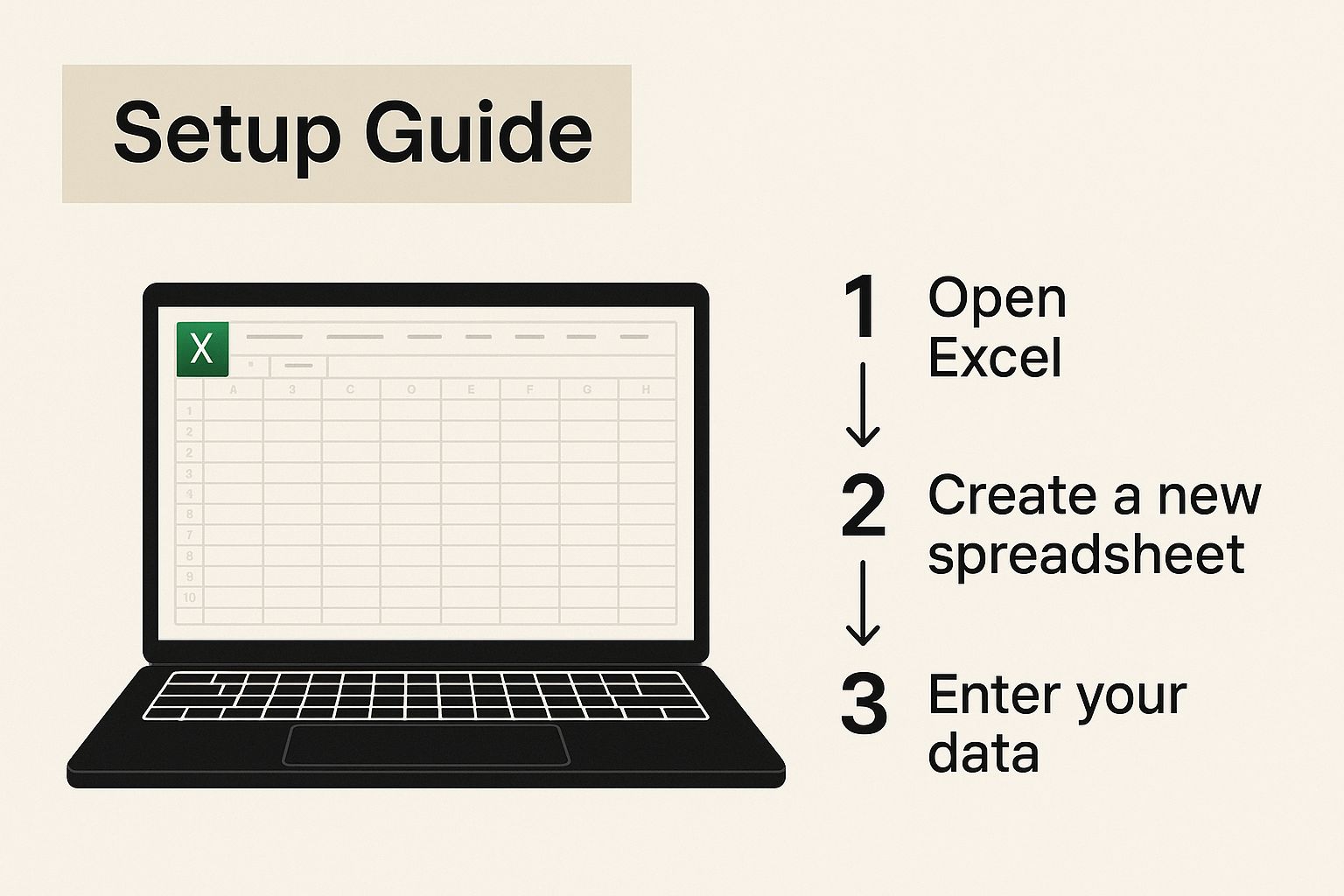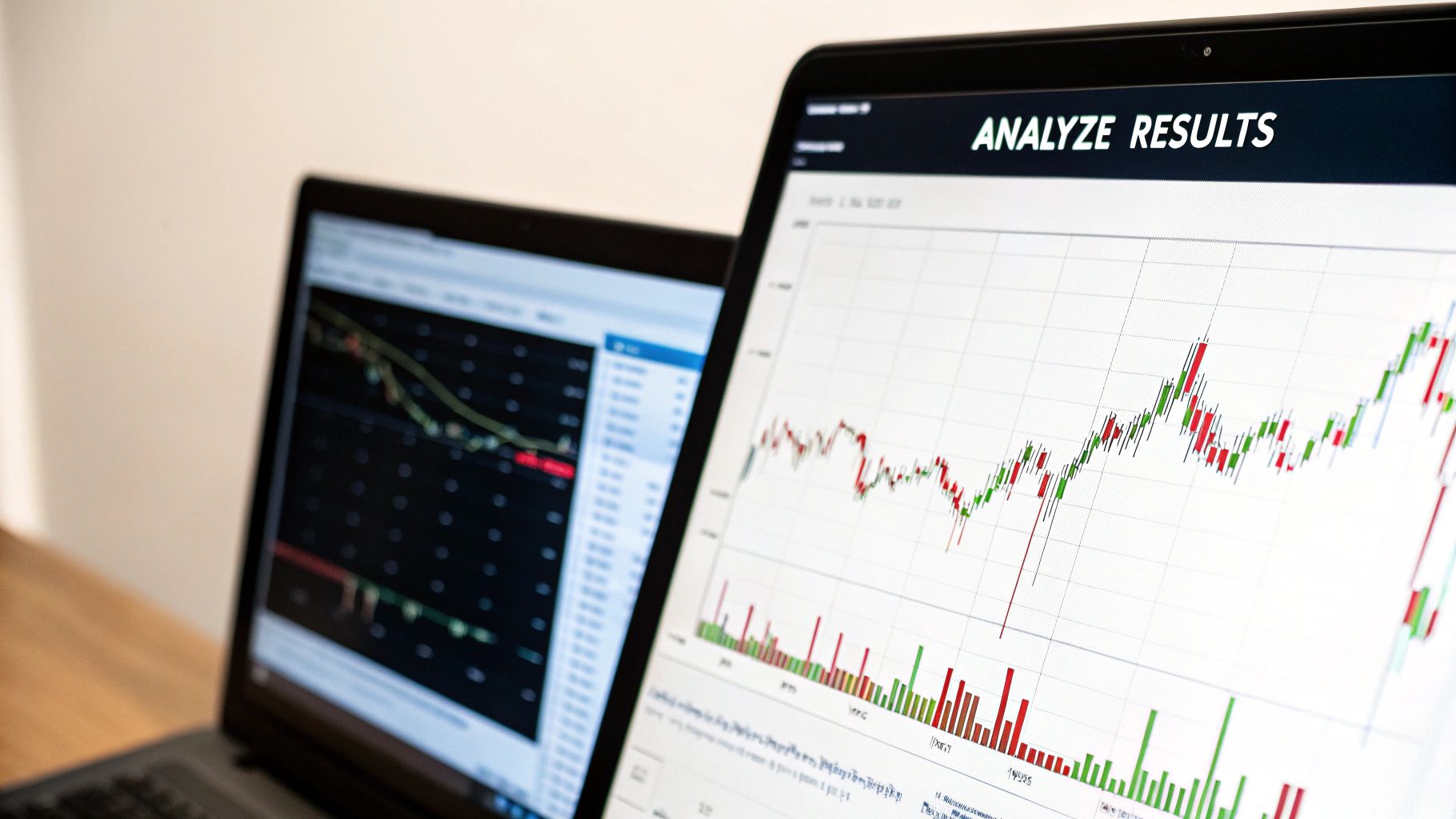If you’re serious about trading, your journal is your single most important tool. A trading journal in Excel is far more than just a spreadsheet; it’s your personalized system for logging, analyzing, and actually learning from every single trade you take. It’s how you stop guessing and start building a real, long-term strategy. This isn’t about finding a shortcut to guaranteed profits, but about committing to a process of continuous improvement.
Why a Custom Excel Journal Is Your Trading Edge

Let’s be honest. Trading without a journal is like driving blindfolded. You might get lucky for a little while, but eventually, you’re going to hit a wall. Every trader knows the sting of emotional decisions—the revenge trade after a tough loss or the FOMO-driven entry that blows up an account. These aren’t just random bad luck; they are predictable patterns rooted in our own psychology.
A well-designed trading journal in Excel is the personal coach that never lets you off the hook. It holds you accountable and shines a bright light on those expensive habits. By forcing you to log your trades, it creates a crucial pause between the market’s chaos and your reaction, giving you space for deliberate, thoughtful action.
Moving Beyond Simple Wins and Losses
A common mistake is thinking a journal is just a running tally of profits and losses. That’s a tiny part of the picture. The real power comes from capturing the why behind every move. What was your emotional state? What was the market doing? Why did you pick that exact entry and exit?
This is where Excel really comes into its own. It’s the perfect tool for building a personalized system that tracks and analyzes your trades, offering a mirror that reflects your discipline—or lack thereof. For a deeper dive, you can learn more about the core benefits of a trading journal in our detailed article.
“The market is a stern teacher, and the journal is your textbook. Ignoring it means you’re choosing to repeat the same lessons—and pay the tuition—over and over again.”
Building Your Foundation for Discipline
At the end of the day, a journal is all about building discipline. It’s the essential bridge connecting your trading plan to what you actually do in the heat of the moment. When you consistently record your actions, you create an undeniable record of your behavior. You can no longer tell yourself stories about your performance; the data doesn’t lie.
This simple habit helps you:
- Spot Negative Patterns: Do you consistently cut winning trades short out of fear? Or maybe you let your losers run way too long, hoping they’ll turn around? The numbers will tell you.
- Refine Your Best Strategies: Discover the exact market conditions and setups where you excel. This lets you focus your energy where it counts.
- Manage Emotional Triggers: Recognize when fear, greed, or overconfidence is driving your decisions instead of your strategy.
This commitment is what separates the pros from the amateurs. It’s not about finding a magical formula for endless profits. It’s about building a robust system for long-term, consistent improvement.
Designing Your Foundational Trade Log
Alright, let’s get practical and build the most important part of your trading journal: the core trade log. This is more than just a spreadsheet for plugging in numbers. Think of it as building the engine for your entire trading analysis system. We’re going to architect this from the ground up, making sure every column has a purpose.
Your blank Excel sheet is where it all begins. Each column we add will capture a critical piece of the puzzle, telling the full story of every trade you take. Let’s start with the hard data—the absolute must-haves.
Laying the Quantitative Foundation
First things first, we need to log the basic facts of each trade. Getting the formatting right on these columns from the very beginning will save you a world of pain later when you’re trying to run calculations. Trust me on this.
Here’s a breakdown of the essential columns I recommend every trader starts with. Think of this as the non-negotiable data you absolutely must track.
| Column Name | Purpose | Example Data Type |
|---|---|---|
| Trade ID | A unique number for each trade. Makes referencing specific trades much easier. |
Number (e.g., 1, 2, 3) |
| Date | When you entered the trade. Essential for filtering and time-based analysis. |
Date (e.g., 10/26/2023) |
| Ticker | The symbol of the asset you traded. |
Text (e.g., AAPL, EUR/USD) |
| Direction | Whether you went long or short. Consistency is key here. |
Text (e.g., Long, Short) |
| Position Size | The number of shares or contracts. |
Number (e.g., 100) |
| Entry Price | The price you paid per share/contract to open the position. |
Currency (e.g., $150.25) |
| Exit Price | The price you received per share/contract to close the position. |
Currency (e.g., $155.75) |
| Stop Loss | Your pre-defined exit price if the trade went against you. |
Currency (e.g., $148.50) |
| Target Price | Your pre-defined profit target. |
Currency (e.g., $160.00) |
Taking a minute to set the “Date” column to a date format or “Entry Price” to currency seems small, but it’s what allows Excel to do its magic later on. Clean, well-structured data is your best friend.
Capturing the Qualitative Story
Now for the part that separates a simple ledger from a genuine learning tool. The numbers tell you what happened, but the qualitative columns tell you why. This is where you’ll find the real “alpha,” or edge, in your trading.
We love to blame the market for our losses, but the real culprit is usually staring back at us in the mirror. The qualitative notes in your journal are what expose your own decision-making flaws so you can fix them.
This is where you need to be brutally honest with yourself. Add these columns to capture the context and your mindset:
- Trade Rationale: Why this trade? In a sentence or two, jot down your setup. Was it a technical breakout? A news catalyst? Be specific. Example: “Price broke above the 50-day moving average on high volume, confirming bullish momentum.”
- Emotional State: How were you feeling when you clicked the button? Anxious? Overconfident? Bored? Experiencing FOMO (Fear Of Missing Out)? Example: “Felt FOMO after a three-day rally and chased the entry.”
- Trade Grade (A-F): After the trade is closed, give yourself a grade. This isn’t about profit or loss; it’s about execution. A profitable trade where you broke all your rules might be a “C,” while a small, planned loss where you followed your system perfectly could be an “A.”
This combination of hard data and self-reflection is what fuels real growth. One trade at a time, you’ll start connecting your actions to your outcomes, building the discipline required for a long-term trading career.
Automating Your Analysis with Essential Excel Formulas
Once you have a good log of your trades, the real work—and the real fun—begins. A simple list of your entries and exits is just raw data. It’s the formulas that breathe life into your spreadsheet, turning it into a powerful analytical tool that does the heavy lifting for you. This is how you start to uncover the hidden patterns in your performance.
Let’s be realistic, manually calculating your profit or loss on every single trade is a recipe for frustration and errors. Automation is your best friend here.
This gives you a quick visual guide for getting your Excel journal set up correctly from the get-go.

When you structure your spreadsheet logically from the start, plugging in formulas becomes a much smoother process.
Calculating Core Trade Metrics
First things first, let’s nail down your Profit/Loss (P/L) for each trade. This is the bedrock of your entire analysis. Let’s assume you’ve set up your journal with ‘Direction’ in column D, ‘Position Size’ in E, ‘Entry Price’ in F, and ‘Exit Price’ in G.
You can use a simple IF statement to handle both your long and short positions automatically. In your P/L column (we’ll use column H), you’d enter this formula for your first trade row (let’s say row 2):
=IF(D2="Long", (G2-F2)*E2, (F2-G2)*E2)
What this does is check if the trade was a “Long.” If it was, it calculates (Exit – Entry) * Size. If not (meaning it was a “Short”), it flips the calculation to (Entry – Exit) * Size. Just drag this formula down the column, and every trade’s P/L is calculated instantly.
Another incredibly useful metric is Return on Investment (ROI). This shows your profit relative to the capital you put at risk. In the next column over (column I), you can calculate it with this:
=(H2 / (F2*E2))
Just make sure to format that cell as a percentage. Seeing a 5% return on a trade is a much more meaningful piece of information than just knowing you made $500. It puts your performance into the context of the risk you actually took.
Uncovering Deeper Insights with Conditional Formulas
Okay, now let’s move beyond individual trade stats and start looking at the bigger picture. This is how you get answers to the really important questions: Which of my strategies actually make money? Am I more profitable on Tuesdays? Do I perform better trading NVDA or SPY?
This is where conditional formulas like SUMIF, COUNTIF, and AVERAGEIF become your secret weapons. These functions let you slice and dice your data without any manual sorting.
-
SUMIF: Perfect for adding up the total profit for a specific setup. For example, if you tag your setups in column K, you can find the total P/L for your “Breakout” strategy with:=SUMIF(K:K, "Breakout", H:H) -
COUNTIF: This is essential for calculating your win rate. A win rate is simply the number of winning trades divided by your total trades. You can get a deeper look into how to calculate your win rate and why it’s so vital. The formula to count just your winners would be:=COUNTIF(H:H, ">0") -
AVERAGEIF: This is fantastic for comparing your average winning trade to your average losing trade—a crucial part of understanding your risk/reward profile.-
Average Winner:
=AVERAGEIF(H:H, ">0") -
Average Loser:
=AVERAGEIF(H:H, "<0")
-
Average Winner:
A quick reality check: If your average winner is $200 but your average loser is $400, you have a negative expectancy, even if you have a high win rate. This single insight can be the wake-up call a trader needs to seriously rethink their risk management.
By setting up these formulas, you’re building a system that updates in real-time as you log new trades. This isn’t just about saving time. It’s about creating an objective, unemotional feedback loop that helps you build discipline and focus on what truly works in your trading.
Getting a High-Level View with a Trading Dashboard
Let’s be honest: a spreadsheet packed with rows of numbers is great for keeping records, but it’s terrible for getting insights at a glance. Staring at a wall of data is a surefire way to get overwhelmed and completely miss the patterns that are right in front of you.
This is where a dedicated dashboard in your trading journal excel file really shines. It’s your command center. By creating a separate sheet, you can translate all that raw data into simple, intuitive visuals that tell you the story of your trading. Think of it as the instrument panel in a cockpit—it gives you immediate feedback on the metrics that actually matter.
PivotTables and PivotCharts are Your Best Friends
The quickest and most powerful way to build a dashboard is with Excel’s PivotTables and PivotCharts. These tools can feel intimidating at first, but they are absolute game-changers for crunching numbers. They’re built to summarize, group, and analyze huge sets of data with just a few clicks.
Instead of wrestling with complex formulas to pull everything together, a PivotTable does all the heavy lifting. It creates a clean summary table from your trade log, which you can then turn into a chart in seconds. The best part? It’s all interactive. You can filter your charts to see performance for a specific month, strategy, or even a single ticker, letting you dig deep without ever touching your original trade log.
The Core Visuals Every Trader Needs
Your dashboard should be personal and reflect your own trading goals. That said, a few core charts deliver a ton of value to just about every trader out there. I recommend starting with these three to build a solid foundation.
- Your Cumulative P/L Curve: This is your equity curve, and it’s the most important chart on your dashboard, period. It’s a simple line chart that plots the running total of your profits and losses over time. Seeing that curve move up and to the right is a huge confidence booster. More importantly, seeing it flatten out or dip is an immediate, undeniable signal that something needs a closer look.
- Strategy Performance Bar Chart: Do you really know which of your setups makes you the most money? A simple bar chart will give you the answer. Use a PivotTable to group your trades by the “Strategy” or “Setup Tag” column, and you can create a chart that visually stacks up the total P/L for each. You might just discover that the strategy you thought was your bread-and-butter isn’t the one driving your best results.
- Win/Loss Distribution Pie Chart: This one is for a quick, high-level snapshot of your win rate. A pie chart gives you a simple visual breakdown of the percentage of your trades that were winners versus losers. While it’s not the deepest metric, it’s a great way to check your overall consistency in a split second.
Here’s a look at how you can pull these elements together. This is a simple but incredibly effective dashboard that visualizes data straight from a trade log.
This layout instantly gives you the vitals: total gain, win rate, and performance by day. You can spot trends without having to sift through hundreds of rows of raw numbers.
Many specialized tools are built on this exact principle. Some advanced Excel templates are designed from the ground up to turn trade data into actionable analysis, with features like automatically generated graphs that let you visualize your stats instantly. You can get some great ideas for your own setup by checking out how these advanced templates are built on platforms like trading-journal-spreadsheet.com.
A quick word of advice: The goal of a dashboard isn’t to look impressive; it’s to be informative. A simple chart that points out a critical flaw in your trading is infinitely more valuable than a complex, flashy one that tells you nothing.
This visual feedback loop is what builds real discipline. It’s a lot harder to ignore a downward-trending equity curve than it is to brush off a few red trades in a spreadsheet. This is how you start building unshakeable confidence in your winning systems and find the conviction to fix—or ditch—the ones that are holding you back.
Taking Your Journal to the Next Level: Finding Your Edge
So, you’ve got the basics down. Your journal is up and running, automatically crunching your core numbers. Now it’s time to dig deeper and find your real edge. A basic log tells you what happened, but we want to understand why it happened. This is where a few smart adjustments can transform your simple trading journal excel file into a serious tool for discovery.

Let’s be honest—most of us struggle with consistency. It’s usually not because the strategy itself is broken, but because our execution has small leaks. A tiny shift in your setup criteria, a moment of hesitation, a bit of FOMO—these little things can completely change your results. The goal here is to catch those subtle but critical details.
Standardize Your Data with Dropdown Menus
One of the quickest wins for better analysis is standardizing your data. If you type “Breakout” one day and “break out” the next, Excel treats them as two completely different things. This leads to a messy, unreliable dataset that makes it impossible to draw accurate conclusions.
The fix? Dropdown menus. They’re a game-changer. By creating predefined lists for your qualitative data points, you make sure every single entry is consistent.
- Trade Setups: List out your specific strategies, like “Breakout,” “Mean Reversion,” or “Trend Following.”
- Emotional State: What were you feeling? Be honest. “Confident,” “Anxious,” “FOMO,” “Disciplined.”
- Mistakes: Catalog your common errors. Think “Moved Stop,” “Chased Entry,” or “Oversized Position.”
This simple feature not only forces objectivity but also makes filtering and sorting your data for the dashboard a clean, one-click affair.
Make Your P/L Column Instantly Scannable
A long column of P/L numbers can be a blur. This is where Conditional Formatting comes in—it’s an awesome Excel feature that automatically color-codes your wins and losses. You can set a simple rule: if the number is positive, make the cell green; if it’s negative, make it red.
This visual feedback is incredibly powerful. You can see winning and losing streaks at a glance, helping you instantly recognize when you’re in a groove or when it might be time to take a break and reassess.
Fine-Tune Your Exits with MAE and MFE
Ready to really level up? Start tracking Maximum Adverse Excursion (MAE) and Maximum Favorable Excursion (MFE). These two metrics, while sounding a bit technical, simply measure the best and worst price points your trade hit while it was open.
- MAE shows you the biggest floating loss your position experienced. For example, if you entered at $100 and it dropped to $98 before going up to your exit, the MAE is $2.
- MFE shows you the highest point of unrealized profit it reached. For example, if you exited at $105 but the price wicked up to $108 first, the MFE is $8.
Tracking these helps you answer crucial questions. “Is my stop-loss way too tight?” “Am I consistently taking profits too early?” If you find that your winning trades regularly have an MFE that’s miles beyond your actual exit price, you’re probably leaving a lot of money on the table.
This kind of disciplined tracking is what separates the hopeful from the methodical. In fact, traders who consistently journal are far better equipped to spot patterns in both their own behavior and the market. If you want to dive deeper into this idea, there’s a great video explaining why journaling is key to trading success.
Common Questions About Excel Trading Journals
Diving into an Excel trading journal for the first time can feel a bit daunting. It’s natural to have questions and wonder if you’re on the right track. Let’s walk through some of the most common hurdles traders run into and get you some clear answers.
If you feel like you’re just logging trades into a void at the beginning, don’t worry—that’s a normal part of the process. Stick with it. The real insights are just around the corner.
How Much Data Do I Need for It to Be Useful?
You can absolutely learn something from your very first entry, but the real, actionable patterns start to show up once you have a decent sample size. A good starting point is to aim for at least 30-50 trades from a single, consistent strategy before you dive deep into analysis.
Why that many? Anything less can easily be skewed by a lucky streak or a string of bad beats. A larger dataset smooths out the market’s random noise and gives you a much more statistically reliable picture of how your strategy actually performs. The goal here is to understand your long-term consistency, not just to analyze a single hot week.
The point of a journal isn’t to judge a handful of trades. It’s to reveal the habits and tendencies that define you as a trader over hundreds of them. Discipline in logging is the first step toward discipline in trading.
What Is the Most Important Metric to Track?
It’s easy to get obsessed with Win Rate, but that metric only tells you half the story. A far more powerful number to focus on is your Profit Factor, which you find by dividing your total profits by your total losses.
This single number reveals how much you make for every dollar you risk. For example, a Profit Factor of 2.0 means you’re making $2 for every $1 you lose. A high win rate means nothing if your few losses are big enough to wipe out all those small gains. This metric forces you to look at the quality of your wins and your overall risk management, which is a critical skill you can learn more about in these essential risk management techniques for traders.
Should I Also Log Missed or Paper Trades?
Yes, absolutely. Journaling trades you planned but didn’t take—those “missed opportunities”—is an incredibly valuable exercise. It forces you to dissect moments of hesitation, fear, or a simple lack of conviction in your plan. What was holding you back?
Paper trading is the perfect, risk-free way to test a new setup or strategy, and you should journal those trades with the same rigor as your live ones.
- For missed trades: Make a note of why you didn’t pull the trigger. Was it fear? Did you miss the entry?
- For paper trades: Follow your plan perfectly to gather clean, unbiased data on the strategy itself.
The easiest way to handle this is to add a “Trade Type” column in your spreadsheet to tag these entries. That way, you build a rich dataset for later review without mixing up the performance metrics from your real-money trades.
Ready to move beyond spreadsheets? TradeReview offers a powerful, automated trading journal that syncs directly with your broker. Track your performance with an interactive dashboard, visualize your trades on a calendar, and get the data-driven insights you need to improve—all for free. Start journaling with TradeReview today.

